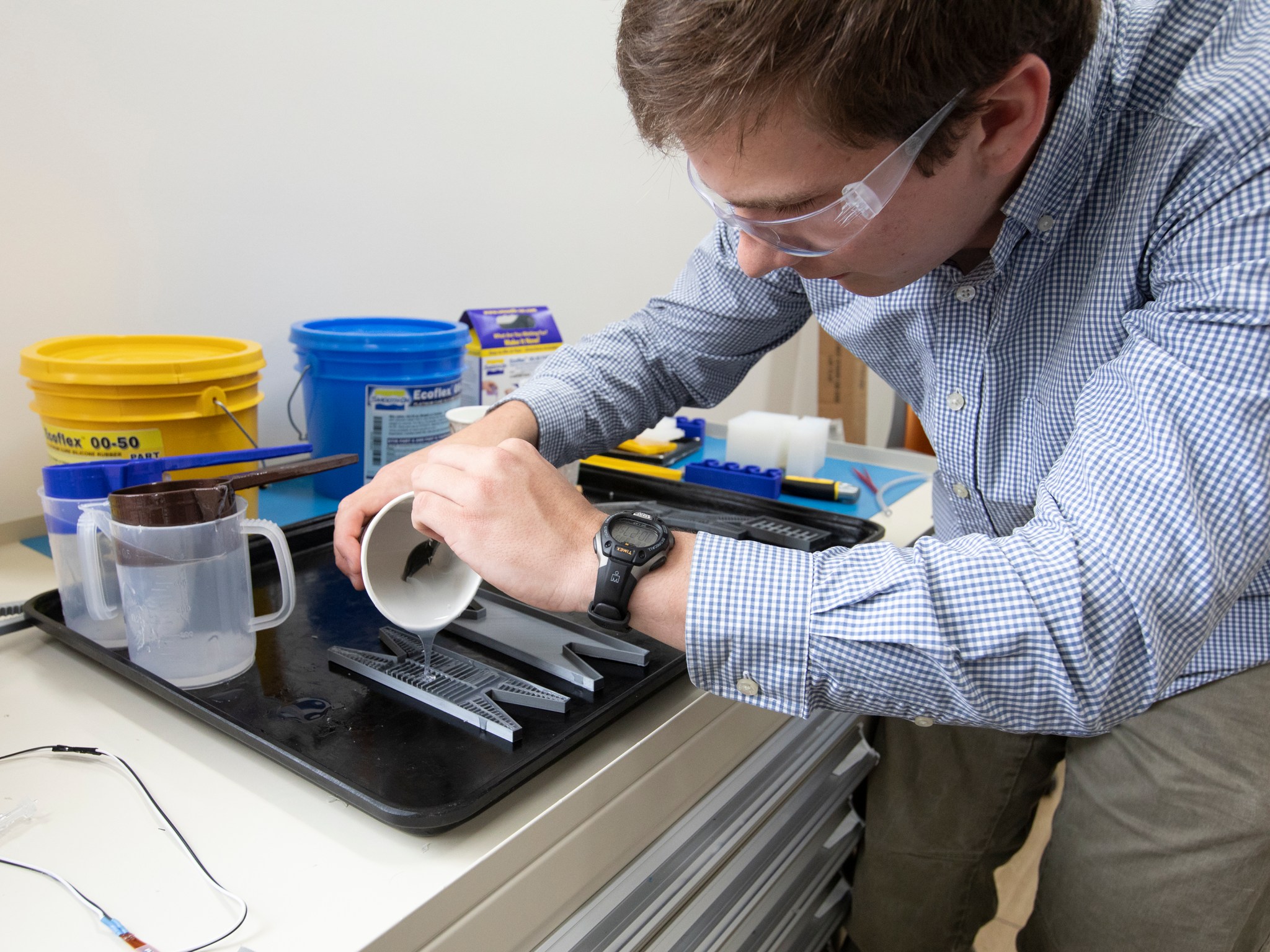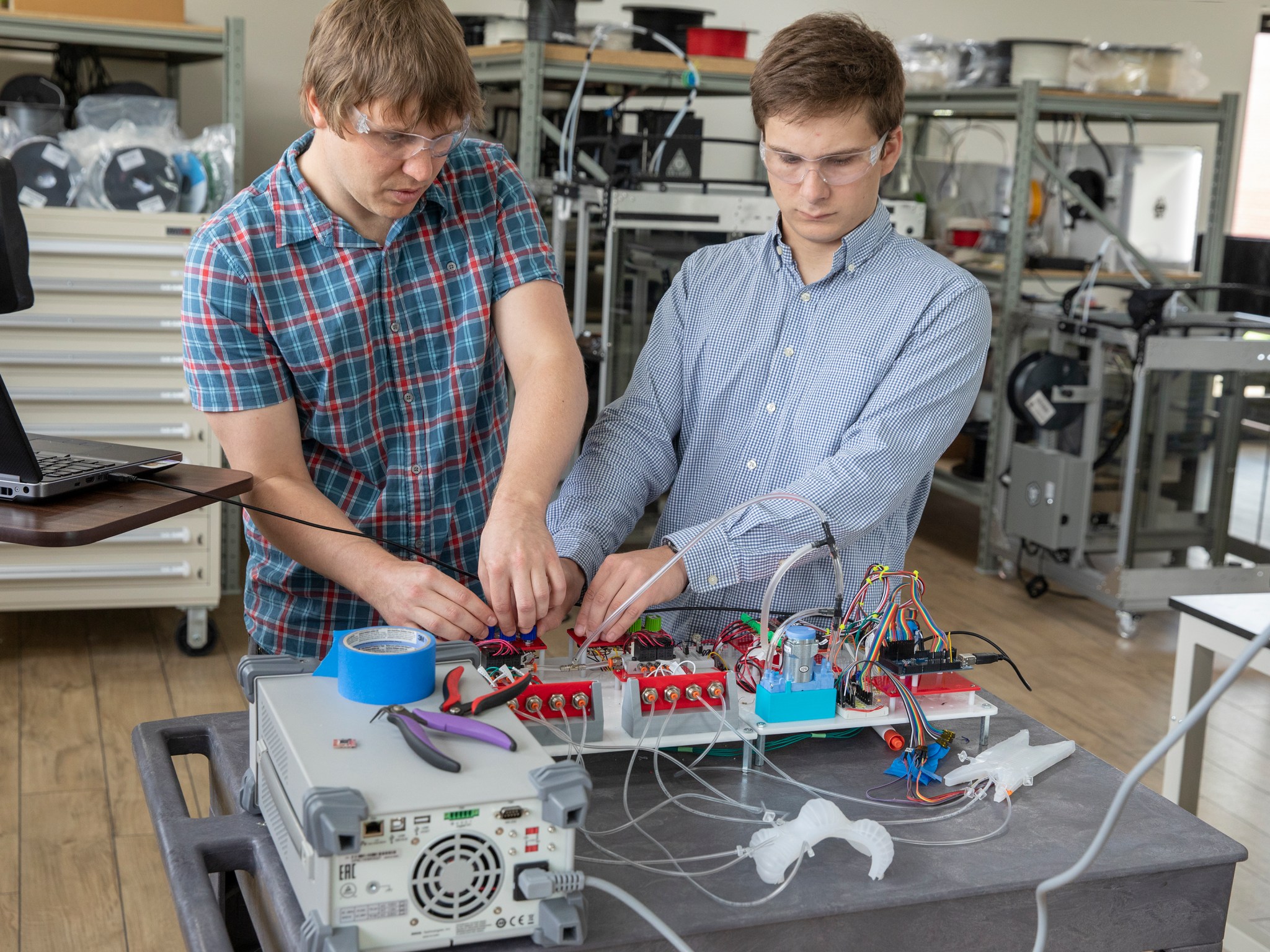Into the Spiderverse’s newest crew of villains include a brilliant scientist named Doctor Octopus who uses flexible robotic arms to commit her dastardly deeds. Her bionic arms can throw objects, aid her in moving quickly in fight scenes, and a host of other functions. While we can leave the evil geniuses to the movies, two genius interns are investigating soft robotics like the supervillain’s incredible arms for viability beyond our planet at NASA’s Langley Research Center in Hampton, Virginia.
In Langley’s makerspace lab, Chuck Sullivan and Jack Fitzpatrick are developing a series of soft robot actuators. “What we’re investigating is the viability of soft robotics in space exploration and assembly,” said Sullivan.
While the word ‘robot’ conjures images of metal arms and gears, soft robotic actuators are bioinspired, looking at the way nature works to create new robot movements. By being constructed from highly flexible materials, soft robots are able to move similarly to living organisms, allowing new ranges of motion that traditional robots simply can’t have. Space applications of these actuators can expand the role of robots in exploration and assembly.
“When you actuate the soft robot, it changes how you use the material properties,” said Fitzpatrick. “A piece of rubber going from flat to the shape of a finger, it changes the material into something else.”
While in the early stages of their research, Sullivan and Fitzpatrick are looking at a series of properties to understand how actuators can be built and used in space. Their current process is to 3D print a mold and then pour in a flexible substance like silicone. By design, the actuator has chambers, or air bladders, that expand and compress based on the amount of air in them.
Currently, these two interns are operating the design through a series of tubes in the air bladders, allowing them to control the movement of the robot. By adjusting the amount of air in the chamber of the soft robotic actuator, the robot can flex and relax, just like a human muscle.
Soft robotics is a relatively novel concept. In fact, both Sullivan and Fitzpatrick are new to the field. Computer Engineer and Principal Investigator James Neillan, along with Co-Principal Investigator Matt Mahlin, developed the intern project to investigate the viability of soft robots in space.
Sullivan was introduced in 2015 through working with in-space assembly groups. “James Neillan and Matt Mahlin invited me to come work on it, knowing what I’ve done with in-space assembly before,” said Sullivan.
Fitzpatrick, on his third internship at Langley, had also never heard of soft robotics prior to this opportunity. “It sounded like an interesting project and I wanted to learn more about it,” said Fitzpatrick.
Creating an actuator is only the first step. Sullivan and Fitzpatrick are starting at ground zero, investigating how this technology can be used in space for both assembly and exploration. From their investigations, they hope to help see what other applications soft robotics could have in the future. To do that, they need to create actuator designs and test them in a series of experiments.
Scientific method dictates that when creating an experiment, a researcher will, first construct a hypothesis, second, test the experiment, and then analyze the data gathered. From there, troubleshooting the new information discovered allows new questions: What worked? What didn’t? What should be changed next?
From there the researcher makes changes to the experiment and tries again, collecting new data and analyzing the information. The process can be repeated until the experiments have accumulated enough data to reach a conclusion to answer the original hypothesis. That’s what Sullivan and Fitzpatrick are doing.
As researchers, the pair of interns has determined four lines of inquiry about the properties of actuators: mobility, joining, leveling, and shaping. Based on these properties, Sullivan and Fitzpatrick plan on establishing what the potential uses and limitations of soft robotics in space exploration and assembly.
“We are trying to see the basic capabilities of soft robots through these four properties. That way when someone down the road says maybe soft robotics is useful in a different application they can look at our work as a baseline,” says Sullivan.
The first is mobility, looking into how the actuator is able to move. For example, moving across the lunar surface. Joining, as the second key property, is vital to understanding exploring how the robots would interlock and link together. Two soft robots could connect together to produce a large temporary shelter.
The third property is leveling, how the actuators can successfully create or adjust a desired surface, like to temporarily fill in the space under a lunar habitat module. “It doesn’t have to be a flat level plain. It can be some other surface shape,” says Fitzpatrick.
Lastly, the fourth property is strengthening, which looks at adding strength to a material by pressurizing it using the air bladders. “We use the actuator to get the soft robot into a position and we lock it into place, using a jamming technique,” said Sullivan. This technique can be used to passively strengthen another structure, like a dust shield.
“We see these four things as the crux of the problem. Once we can accomplish those in individual unit tests, we would like to figure out ways to combine them, so maybe we combine mobility and joining.” Sullivan explained.
The hope is to use soft robots in situations that are “dangerous, dirty, or dull,” according to Fitzpatrick, to help keep astronauts safe and productive while conducting their lives in space and other planetary bodies.
In early May, experts from a variety of disciplines and fields will come to Langley to provide feedback on Fitzpatrick’s and Sullivan’s designs and research so far. With this feedback, Sullivan and Fitzpatrick can learn about additional applications and questions for further inquiry as the project continues through the summer.
Andrea Lloyd
NASA’s Langley Research Center






























